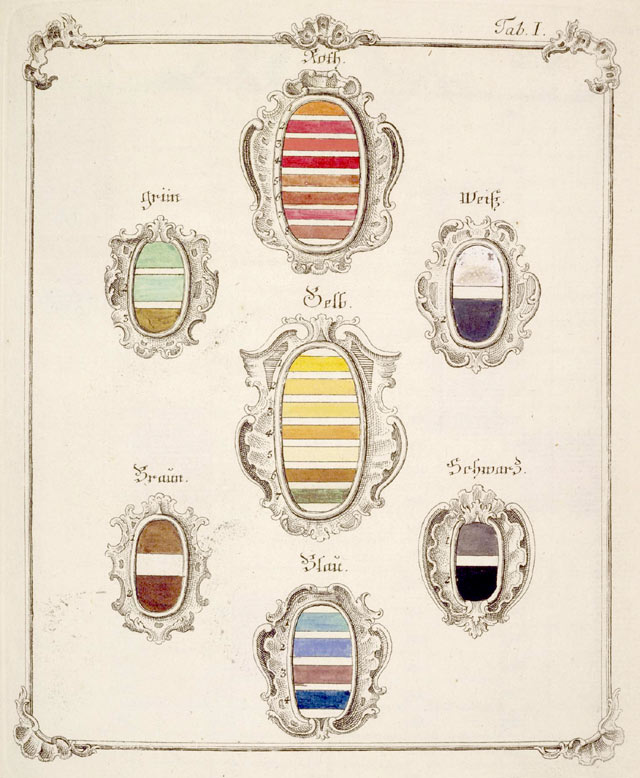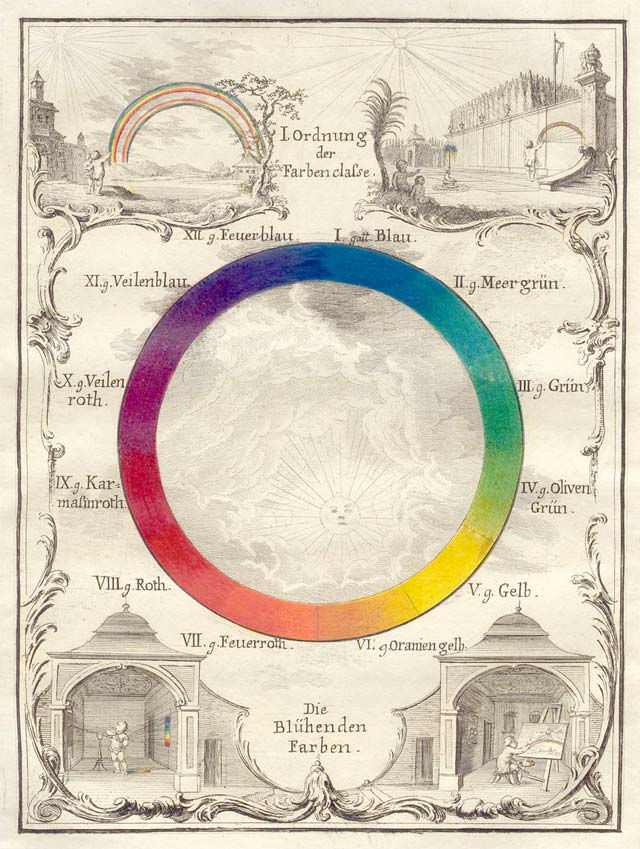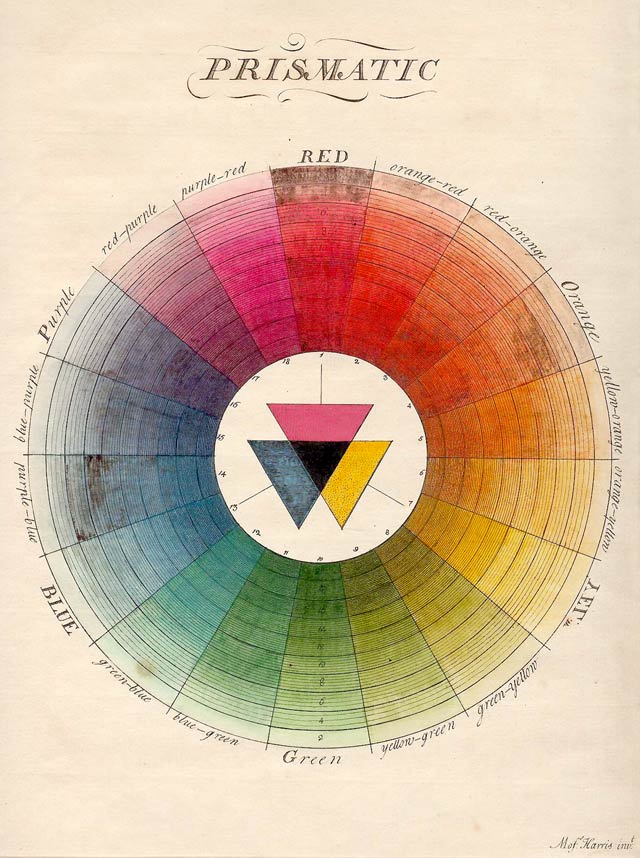Welcome back to my salute to the gorgeous, fallible history of color wheels through the years. The first post on color wheels rolled through the mid-1800s, when Enlightenment-era values of close observation and the scientific method exploded many then-prevalent theories, while simultaneously expanding the flat color wheel into bold new shapes.

Take mathematician Tobias Mayer’s color triangle, first introduced to much hullabaloo in 1758 and shown above in a simplified version by physicist Georg Christian Lichtenberg. Mayer’s clear-eyed premise reflected his quantitative background, while proving remarkably useful for everyday color mixing by working artisans. Mayer began with the notion of three “pure” colors - red, yellow and blue - and chose cinnabar, gamboge, and azurite as the optimal pigments to represent each. He migrated these pure colors to the three corners of a triangle, then filled in the triangle’s body with progressive gradations between these pure shades. Mayer’s original triangle included 12 gradations on each side, representing the maximum degree of variance he believed the human eye could perceive; Lichtenberg slimmed this down to 7 gradations per side. In Mayer’s triangle, one could step from one pure-color corner to the next and know at each step exactly what proportion of red, yellow and blue comprised that color. The triangle’s central block had an exactly equal proportion of red, yellow and blue (r4y4b4, in Mayers’ notation). Mayers’ full color-triangle added a black-and-white axis to this mix, showing how systematic additions of these colors brightened or darkened colors.
All in all, Mayers’ algebra brought his color universe to 819 shades - woefully short of the dizzying range in any modern paint store, but still not too shabby. Mayers’ thinking spawned numerous other color triangles, including the 3-D version pictured below by Johann Heinrich Lambert.

Mayer lives on in our modern incarnations of color as CMYK (cyan-magenta-yellow-black/white). Any crackling cathode-ray television with its glowing color pixels operates more or less according to his precepts.
The painter Philipp Otto Runge was the next German to corner the market on color wheels and their related manifestations. His 1807 model took Mayer’s notion of three “pure” colors, plus black-and-white, and spread these ideas over and inside a 3-D color sphere (complete with cross-sectioning). Goethe gave Runge a conclusive shout-out in his 1810 landmark work, Theory of Colors, but Runge’s color notoriety was short-lived. In 1839, his model gave way to Michel Eugène Chevreul’s hemispherical system (below).

Chevreul arranged his 72 colors in a hemisphere, with similar proportional relationships between shades as those posited by Mayer. The use of black and white as a lightening or darkening agent was alluringly called the “nero” factor. Chevreul’s biggest scientific accomplishments spill beyond his color hemisphere: a past-master of animal fats, he invented an early form of soap and pioneered the study of gerontology while living himself to age 102. He also described a phenomenon now called Chevreul’s illusion: the way two identical colors of different intensities, when placed adjacent to each other, seem brighter at the edge where they join.

In 1900, Albert Henry Munsell’s cylindrical system (above), brought color theory into the twentieth century with an appropriately futuristic visual model. Munsell opted for a three-dimensional cylinder, in which the three axes showed hue, value (lightness or darkness), and chroma (color purity). In quantifying color using these three values, Munsell’s model described colors more scientifically than previous models, which themselves cracked the color wheel concept wide open in favor of more ersatz shapes: Hermann von Helmholtz’s cone in 1860, William Benson’s tilted cube in 1868, and August Kirschmann’s grandiloquent sounding “slanted double-cone” from 1895.
Munsell’s color cylinder was the stake driven in the heart of the history of daffy color wheels. A few models have emerged since Munsell - notably CIELAB and CIECAM2 - but Munsell’s system is still used by, among others, ANSI to identify skin and hair colors for forensic pathology, the USGS for matching soil colors, in prosthodontics for selecting tooth shades for dental restorations, and by breweries for matching beer colors.

However inadequate, scientifically speaking, it is to describe the color-spectrum using a wheel-shaped model, there’s an irresistible fitness about marrying circles with color. As a geometric figure, circles possess a certain strength, a self-contained quality in which a smooth, unperturbed body can be imagined to hold an entire universe. Sometimes the pod will crack, spilling its contents with rampant energy, or maybe the circle holds indefinitely. For an entity as slippery and ubiquitous as color, only a circle can be imagined as a perfect enough shape to contain all of it.
» Read More...

























































